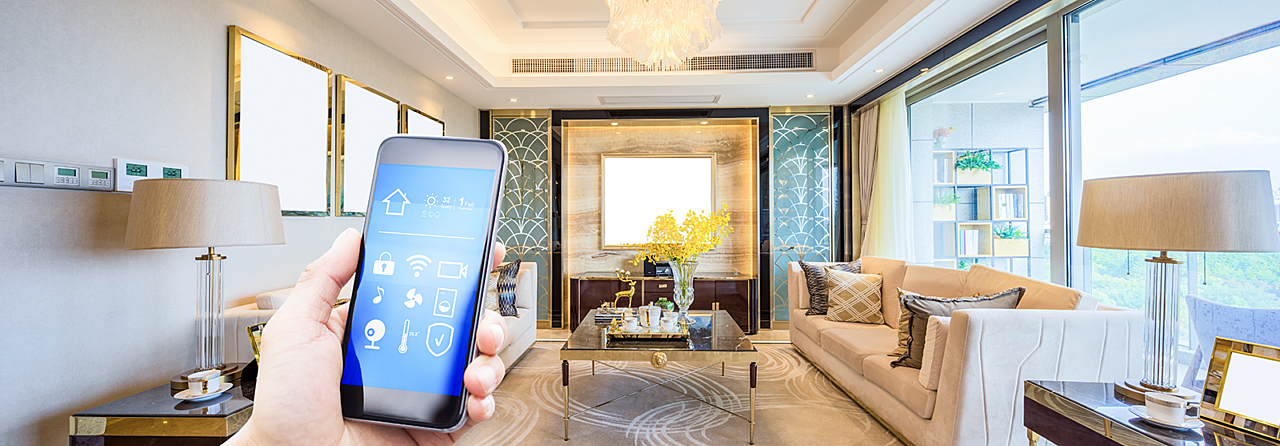Source: www.hiri.org, October 2021
From Wi-Fi-enabled speakers to video doorbells and lightbulbs controlled via mobile apps, our daily lives are becoming smarter and more integrated. So, it only makes sense that the convenience of smart-home tech would be integrated where we spend most of our time: our homes.
Smart-home technology is a booming industry — one worth an estimated $58.5 billion in 2020 and forecasted to exceed $179 billion in 2025. To analyze the key players, trends, and channels in this market, Omdia compiled a 2021 State of the Smart Home report for the Home Improvement Research Institute.
The report defines the market’s scope to include all devices that have digital connectivity and act as part of a smart home. This includes pointing devices limited to Bluetooth®, as well as devices that are part of a complete ecosystem of devices with machine-to-machine connectivity. Devices are also defined as smart if they can be digitally commanded/controlled.
That’s a lot of ground to cover. Thankfully, we’ve broken down the 2021 State of the Smart Home and are here to deliver some crucial takeaways with the help of Omdia Senior Principal Analyst Blake Kozak:
- In 2020, the consumer electronics device category was the largest in the Americas region. Consisting of smart speakers, connected major home appliances, and connected health devices, this category was worth about $11 billion and represented 59% of smart-home device revenue. The second-largest category in 2020 was climate control, worth about $4 billion.
Kozak says touchpoints are a major reason for the popularity of these categories. Depending on the level of automation, a consumer may not have to interact with a device if the automation is based on motion, occupancy, or the brightness of a room, for example. “The level of interaction with a device and perceived value plays an important role,” he said.
- Omdia found that retail was the most popular channel in 2020, representing 88% of smart-home device shipments in the United States. However, Kozak predicts that the biggest upcoming opportunities outside of retail lie within the multifamily and homebuilding industries.
“We estimated that the number of apartments in the U.S. with smart devices will increase from about 930,000 in 2020 to 11.9 million in 2025,” Kozak said. Similarly, single-family homebuilders are expected to begin offering smart-home devices as standard, rather than as part of an upgrade package.
As smart-home technology becomes more ubiquitous, get ready for a positive impact on additional channels.
- Certain megatrends could influence the smart-home market in 2022.
For example, wireless interoperability standard Matter could have a positive impact on the DIY retail market, because it aims to simplify buying smart-home products and will presumably make things simpler for installers and manufacturers. Theoretically, consumers will be able to buy any smart-home device with the Matter logo and have it work with whichever platform they choose, eliminating the need to install dozens of apps in order to onboard devices. This means that increased disruption and opportunity could arise from adjacent segments.
“Matter could have the biggest impact for adjacent markets like homebuilders, multifamily property managers, and insurance companies,” Kozak said.
- Overall, COVID-19 contributed to a smart-home market slowdown in 2020, driving a shift from professional services to e‑commerce and DIY solutions. However, there is an opportunity for pandemic-driven smart products to emerge, such as more touchless technologies, according to Kozak.
“Both Arlo and Alarm.com introduced touchless video doorbells. Although these products already offered people detection, these brands took it one step further to allow homeowners to be notified without the need to push the doorbell.
“I believe we will see similar technology with door locks, where ultra-wideband could be deployed and replace Bluetooth for a better and more accurate experience.”
Kozak also believes that due to the resurgence of COVID-19 variants, many businesses have delayed returning to offices, meaning more people are still at home than ever before, which could lead to more air quality sensors and smart thermostat purchases.
- Looking forward, 2021 and 2022 will likely be record years for product announcements.
In addition to wellness-related innovations, Kozak believes these upcoming breakthroughs will focus on security, voice, radars, and energy/water management. Just last year, an entirely new category was created by pairing digital assistant technology (such as Alexa and Google Assistant) with security devices, including video doorbells.
“Creativity is an integral part of any smart home,” Kozak said. “For the consumer, this means creating scenes and automation that fit their needs.”
HIRI would like to extend a huge thanks to Kozak for his input. To access the full 2021 State of the Smart Home report and to get more details about where the market is headed in the coming years, be sure to become a HIRI member.

